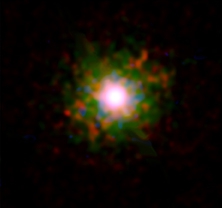Radiation/Analysis/Laboratory

This laboratory is an activity for you to analyze an astronomical situation. While it is part of the astronomy course principles of radiation astronomy, it is also independent.
Astronomical analysis is the detailed examination of the elements or structure of some astronomical thing (an entity, source, or object), typically as a basis for discussion or interpretation.
Once an astronomical situation has been selected, it must be separated into its constituent elements, for example, the identification and measurement of the chemical constituents of a substance or specimen.
You may choose an astronomical situation to dissect.
I will provide one example of this process. Provide any questions you may have on the discussion page.
Control groups
[edit | edit source]A control group for astronomical analysis may be found in any astronomy article. It is likely to consist of
- an aim, or objective, of an investigation of an astronomical situation or event.
- a method, or approach, to hopefully solve or resolve the situation, or understand the event.
- a comparison with various astronomical models, usually two.
- drawing one or more, or some conclusions.
- choosing which model seems to work best.
Analytical X-ray astronomy
[edit | edit source]Analytical X-ray astronomy is applied to an astronomy puzzle in an attempt to provide an acceptable solution. Consider the following puzzle.[1]
"High-mass X-ray binaries (HMXBs) are composed of OB supergiant companion stars and compact objects, usually neutron stars (NS) or black holes (BH). Supergiant X-ray binaries (SGXBs) are HMXBs in which the compact objects orbit massive companions with orbital periods of a few days (3–15 d), and in circular (or slightly eccentric) orbits. SGXBs show typical the hard X-ray spectra of accreting pulsars and most show strong absorption as obscured HMXBs. X-ray luminosity (Lx) increases up to 1036 erg·s−1 (1029 watts)."[1]
The mechanism triggering the different temporal behavior observed between the classical SGXBs and the recently discovered supergiant fast X-ray transients (SFXT)s is still debated.[2]
"Aim: use the discovery of long orbits (>15 d) to help discriminate between emission models and perhaps bring constraints on the models."[1]
"Method: analyze archival data on various SGXBs such as has been obtained by INTEGRAL for candidates exhibiting long orbits. Build short- and long-term light curves. Perform a timing analysis in order to study the temporal behavior of each candidate on different time scales."[1]
"Compare various astronomical models:
- direct spherical accretion
- Roche-Lobe overflow via an accretion disk on the compact object."[1]
Draw some conclusions: for example, the SGXB SAX J1818.6-1703 was discovered by BeppoSAX in 1998, identified as a SGXB of spectral type between O9I−B1I, which also displayed short and bright flares and an unusually very low quiescent level leading to its classification as a SFXT.[2] The analysis indicated an unusually long orbital period: 30.0 ± 0.2 d and an elapsed accretion phase of ~6 d implying an elliptical orbit and possible supergiant spectral type between B0.5-1I with eccentricities e ~ 0.3–0.4.[2] The large variations in the X-ray flux can be explained through accretion of macro-clumps formed within the stellar wind.[2]
Choose which model seems to work best: for SAX J1818.6-1703 the analysis best fits the model that predicts SFXTs behave as SGXBs with different orbital parameters; hence, different temporal behavior.[2]
Now it's your turn
[edit | edit source]The external links below will help you to find an article of interest. Read the article to look for where and how the authors resolved a situation using observational experiments.
Outline their approach and method per the control group above or compose your own.
Hypotheses
[edit | edit source]- A successful way to teach analysis in astronomy is through learning by doing.
See also
[edit | edit source]References
[edit | edit source]- ↑ 1.0 1.1 1.2 1.3 1.4 Marshallsumter (April 15, 2013). X-ray astronomy. San Francisco, California: Wikimedia Foundation, Inc. http://en.wikipedia.org/wiki/X-ray_astronomy. Retrieved 2013-05-11.
- ↑ 2.0 2.1 2.2 2.3 2.4 Zurita Heras JA, Chaty S (2009). "Discovery of an eccentric 30 day period in the supergiant X-ray binary SAX J1818.6–1703 with INTEGRAL". Astronomy and Astrophysics 493 (1): L1. doi:10.1051/0004-6361:200811179.
External links
[edit | edit source]- Bing Advanced search
- Google Books
- Google scholar Advanced Scholar Search
- International Astronomical Union
- JSTOR
- Lycos search
- NASA/IPAC Extragalactic Database - NED
- NASA's National Space Science Data Center
- NCBI All Databases Search
- Office of Scientific & Technical Information
- PubChem Public Chemical Database
- Questia - The Online Library of Books and Journals
- SAGE journals online
- The SAO/NASA Astrophysics Data System
- Scirus for scientific information only advanced search
- SDSS Quick Look tool: SkyServer
- SIMBAD Astronomical Database
- SIMBAD Web interface, Harvard alternate
- SpringerLink
- Taylor & Francis Online
- Universal coordinate converter
- WikiDoc The Living Textbook of Medicine
- Wiley Online Library Advanced Search
- Yahoo Advanced Web Search
{{Chemistry resources}}{{Charge ontology}}{{Geology resources}}{{Principles of radiation astronomy}}{{Reasoning resources}}
